Durational reduction in English (and Polish) words shows a contextual frequency effect
APAP 2019
Kamil Kaźmierski, WA at AMU in Poznań
June 21st, 2019
Overall frequency effect
Higher lexical frequency → Shorter duration (e.g. Jurafsky et al. 2001)
Perhaps caused by speakers: frequency of use causes articulatory reduction
Perhaps moderated by listeners' expectations: highly frequent forms don't have to be pronounced carefully
Such reduction could result from online computation, performed on abstract phonological representations (cf. Levelt et al. 1999)
Contextual frequency effect on variation
| Language | Effect | Source |
|---|---|---|
| English | Prevocalic word-final /t/ glottalized more in words typically followed by consonants | Eddington & Channer (2010) |
| English | Word-final /t,d/ deletion more likely in words typically followed by consonants | Raymond et al. (2016) |
| English | Unstressed ING more likely to be /ɪn/ in words frequently occurring in /ɪn/ favoring contexts | Forrest (2017) |
| Spanish | Latin /fV-/ words frequently occurring after word-final non-high vowels likely to be |
Brown & Raymond (2012) |
| New Mexican Spanish | Word-initial /s/ more likely to be reduced ([s] › [h] › [Ø]) in words often preceded by word-final non-high vowels | Raymond & Brown (2012) |
| English | Words typically predictable reduce in duration more | Seyfarth (2014) |
A table formatted this way will look OK
html 'entities' taken from here: https://onlineutf8tools.com/convert-utf8-to-html-entities
Predictability and Informativity
Predictability
How likely is the current word given the word the speaker said right before it?
Transitional/conditional probability (cf. Jurafsky et al. 2001): P(wi|wi−1)=C(wi−1wi)C(wi−1)
One problem: bigrams with 0 occurrences in the corpus
A solution: add 1 to each bigram count
A better solution: Modified Kneser-Ney smoothing (cf. Chen & Goodman 1998) (r-cmscu R package)
High vs. low predictability
nice home
Lower (< 0.001) predictability of home given nice
fortress-like home
Higher (0.412) predictability of home given fortress-like
Higher predictability → More reduction
nice home
Lower predictability of home given nice
→ Less reduction in home
fortress-like home
Higher predictability of home given fortress-like
→ More reduction in home
Higher predictability → More reduction
Right-context predictability: How likely is this word, given the word the speaker is about to say next?
home wrecker
Higher predictability of home given wrecker
→ More reduction in home
home course
Lower predictability home given course
→ Less reduction in home
Two different predictability "profiles"

Informativity :: How unpredictable from its context is this word on average?
Calculating Informativity
P(W=w|C=ci)
Take Kneser-Ney smoothed probability of a particular word token in a particular context
Calculating Informativity
logP(W=w|C=ci)
Seyfarth used bans (base 10 logarithm) as is apparently usual, I used natural logarithm (R's default) in nsp, corrected it to bans for gpsc
Calculating Informativity
N∑i=1logP(W=w|C=ci)
Calculating Informativity
1NN∑i=1logP(W=w|C=ci)
Calculating Informativity
−1NN∑i=1logP(W=w|C=ci)
Steven T. Piantadosi, Harry Tily, & Edward Gibson 2011. "Word lengths are optimized for efficient communicationTitle", Proceedings of the National Academy of Sciences 108(9), 3526-3529.
Informativity vs. Frequency
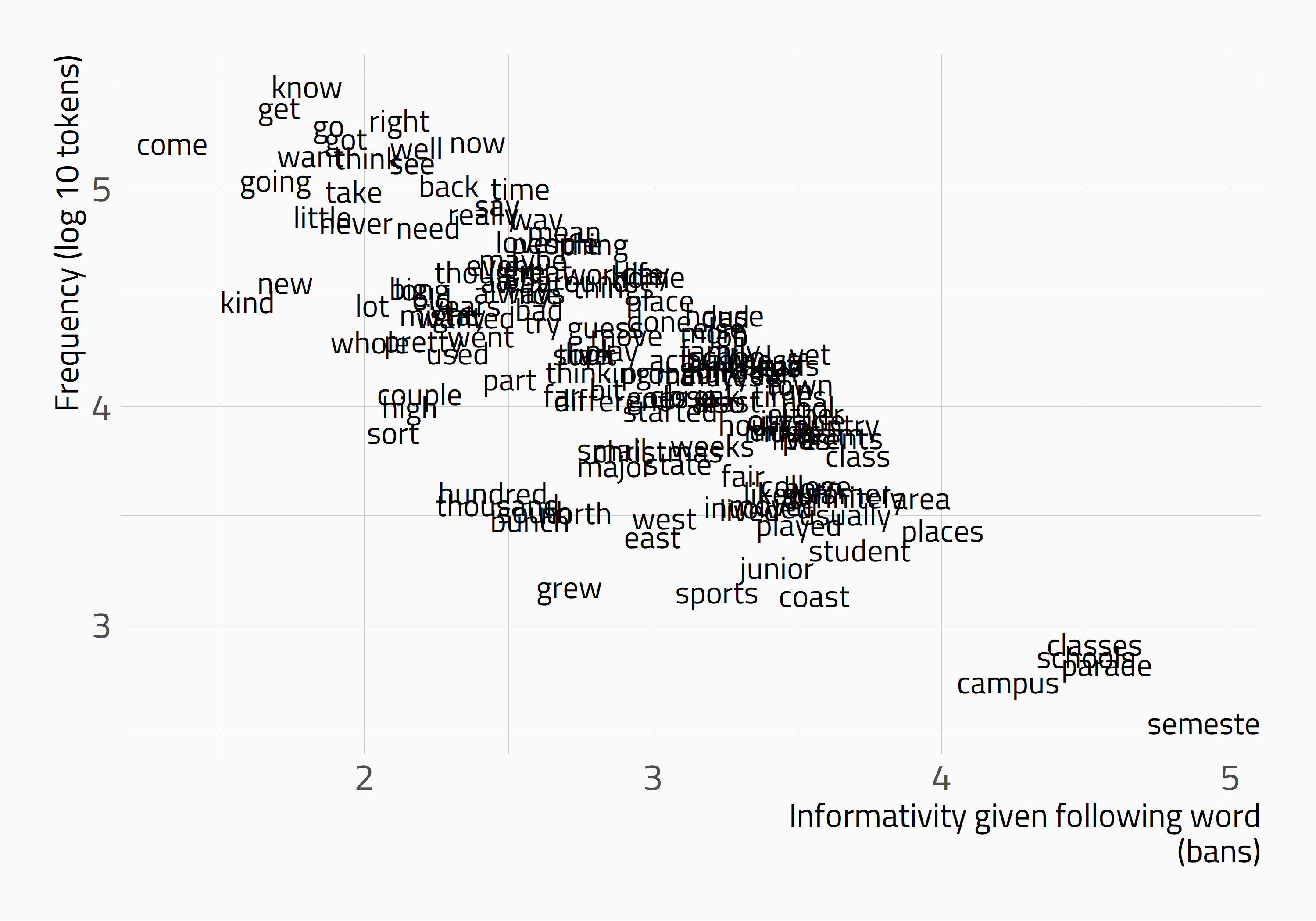
Predictability vs. Informativity
Word frequently occurs in low-predictability contexts → high informativity
Predictability vs. Informativity
Word frequently occurs in low-predictability contexts → high informativity
Word frequently occurs in high-predictability contexts → low informativity
Target study: Seyfarth (2014)
Durational reduction in Buckeye (Pitt et al. 2007) and Switchboard-1 Release 2 (Calhoun et al. 2009; Godfrey & Holliman 1997)
Predictability and informativity estimateted from Fisher Part 2 corpus (Cieri et al. 2005)
Findings:
Higher left-context and right-context predictability → More reduction
Higher right-context (both corpora) or left-context (Switchboard) informativity → Less reduction
Implications:
Predictability and reduction: could be an online effect
Informativity and reduction: suggests storage of reduced forms
Research questions
RQ1: Do the results of Seyfarth (2014) replicate on another English dataset?
Research questions
RQ1: Do the results of Seyfarth (2014) replicate on another English dataset?
RQ2: Do these effects generalize to Polish?
Method
Model architecture (N = 7,158)
- Response:
Word duration
Model architecture (N = 7,158)
- Response:
Word duration
- Predictors of theoretical interest:
Predictability given previous,Informativity given previous,Predictability given following,Informativity given following
Model architecture (N = 7,158)
- Response:
Word duration
- Predictors of theoretical interest:
Predictability given previous,Informativity given previous,Predictability given following,Informativity given following
- "Control" predictors:
Part of speech,Orthographic length,No. of syllables,Dialect,Average speaking rate,Rate deviation
Model architecture (N = 7,158)
- Response:
Word duration
- Predictors of theoretical interest:
Predictability given previous,Informativity given previous,Predictability given following,Informativity given following
- "Control" predictors:
Part of speech,Orthographic length,No. of syllables,Dialect,Average speaking rate,Rate deviation
- Random terms:
(1|Word),(1 + Informativity given following + Informativity given previous | Speaker)
Results
Predictability given following
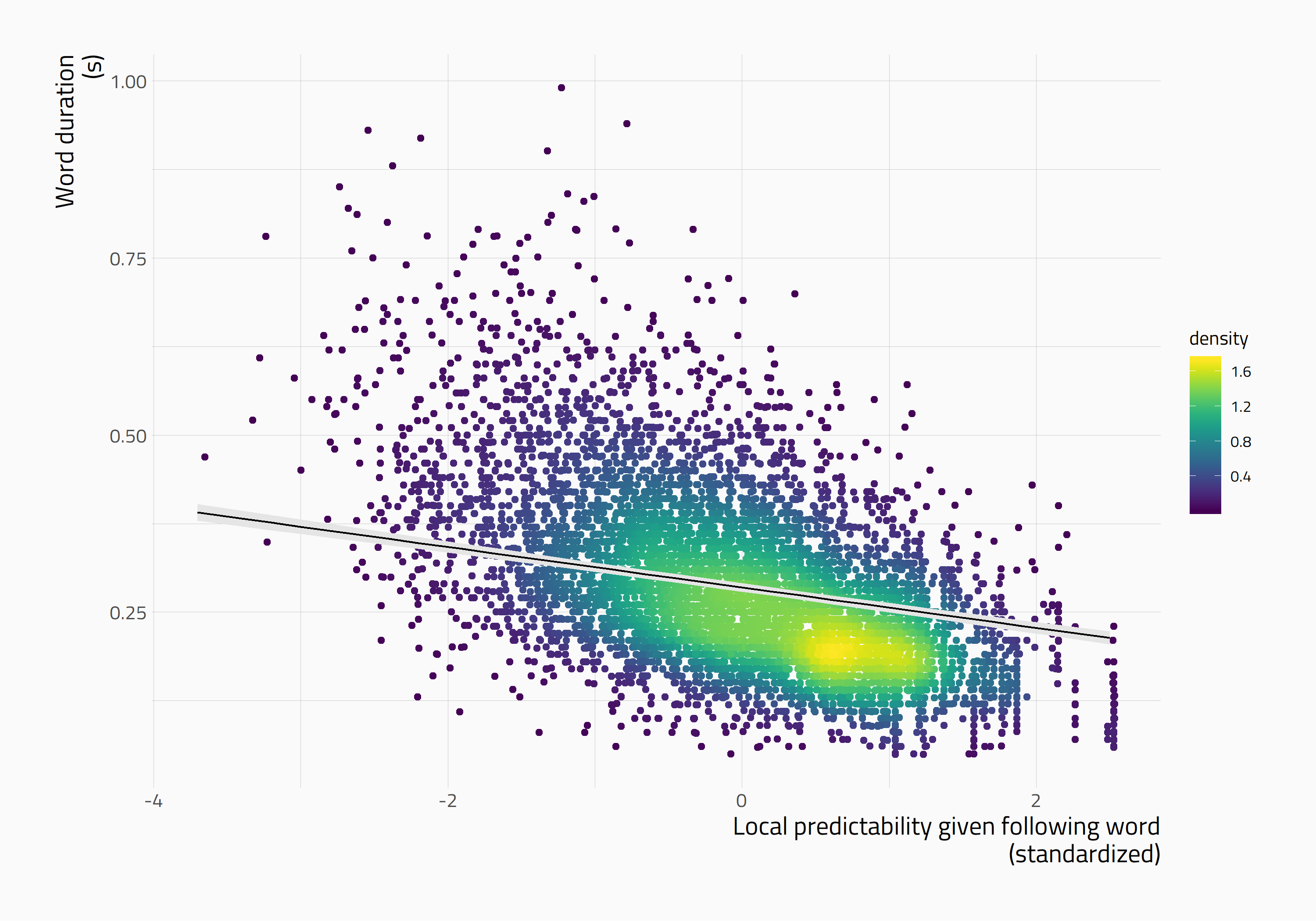
β = -0.029, p < 0.001
Informativity given following
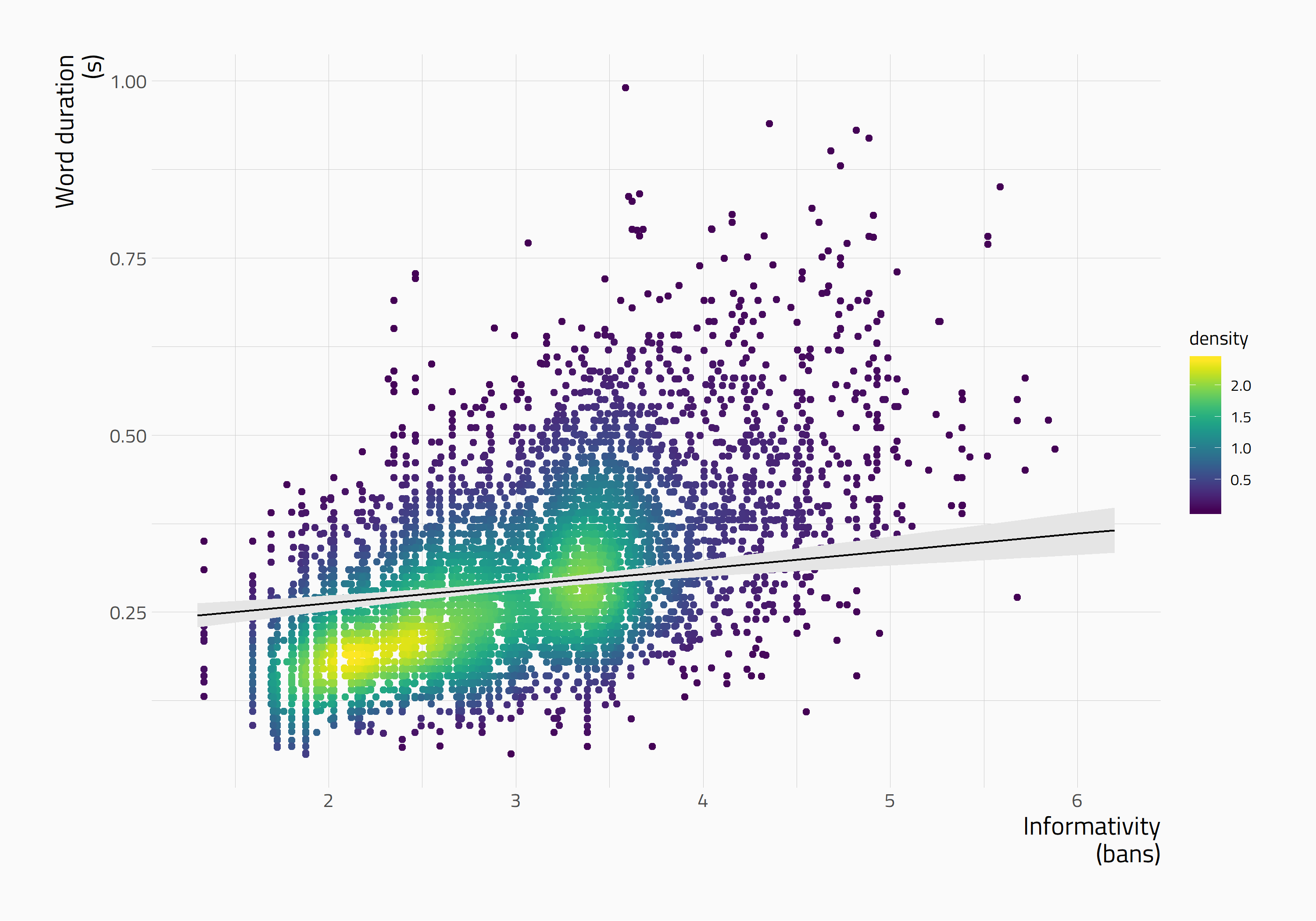
β = 0.025, p < 0.001
Source of Polish data (N = 10,588)
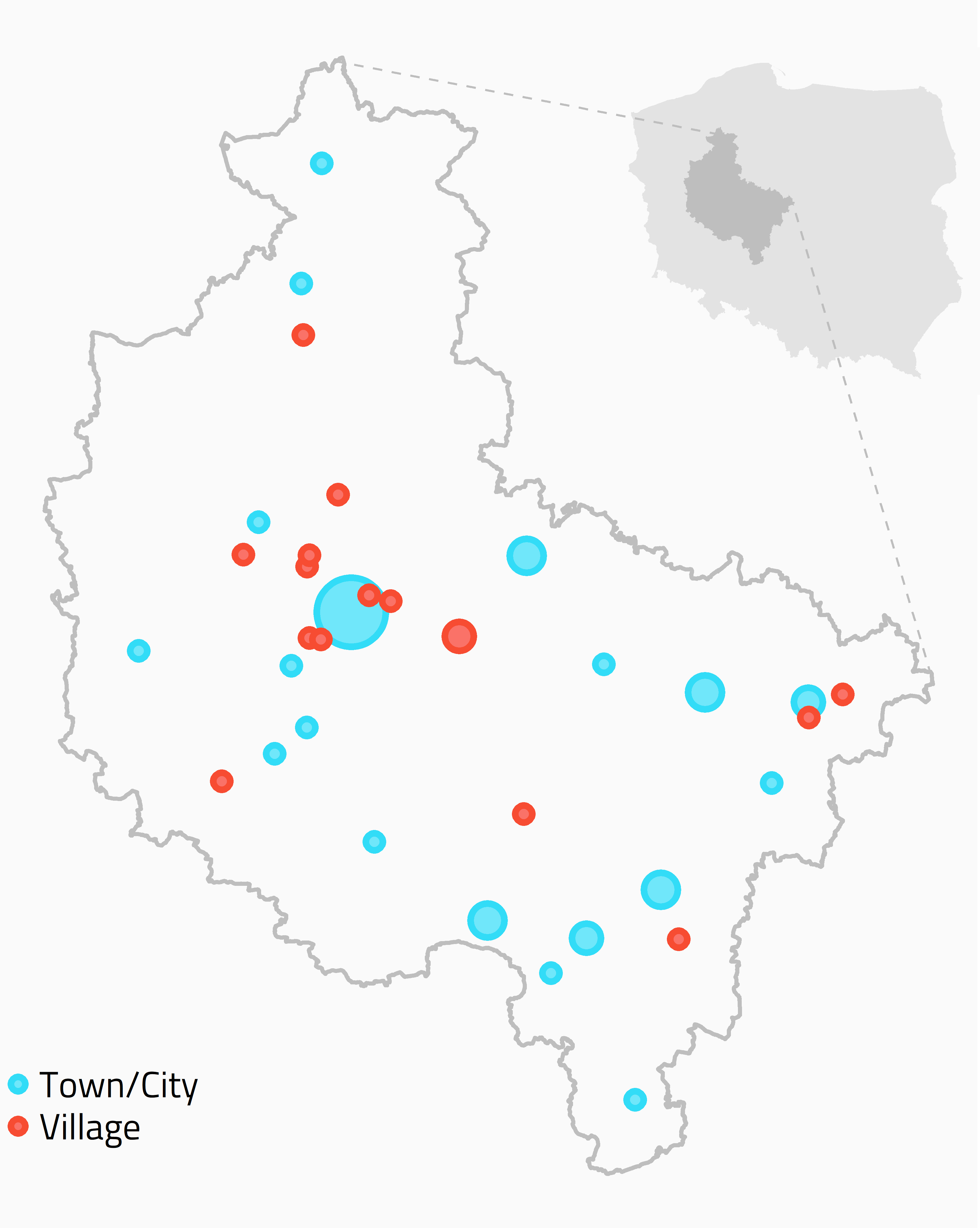
Predictability given previous
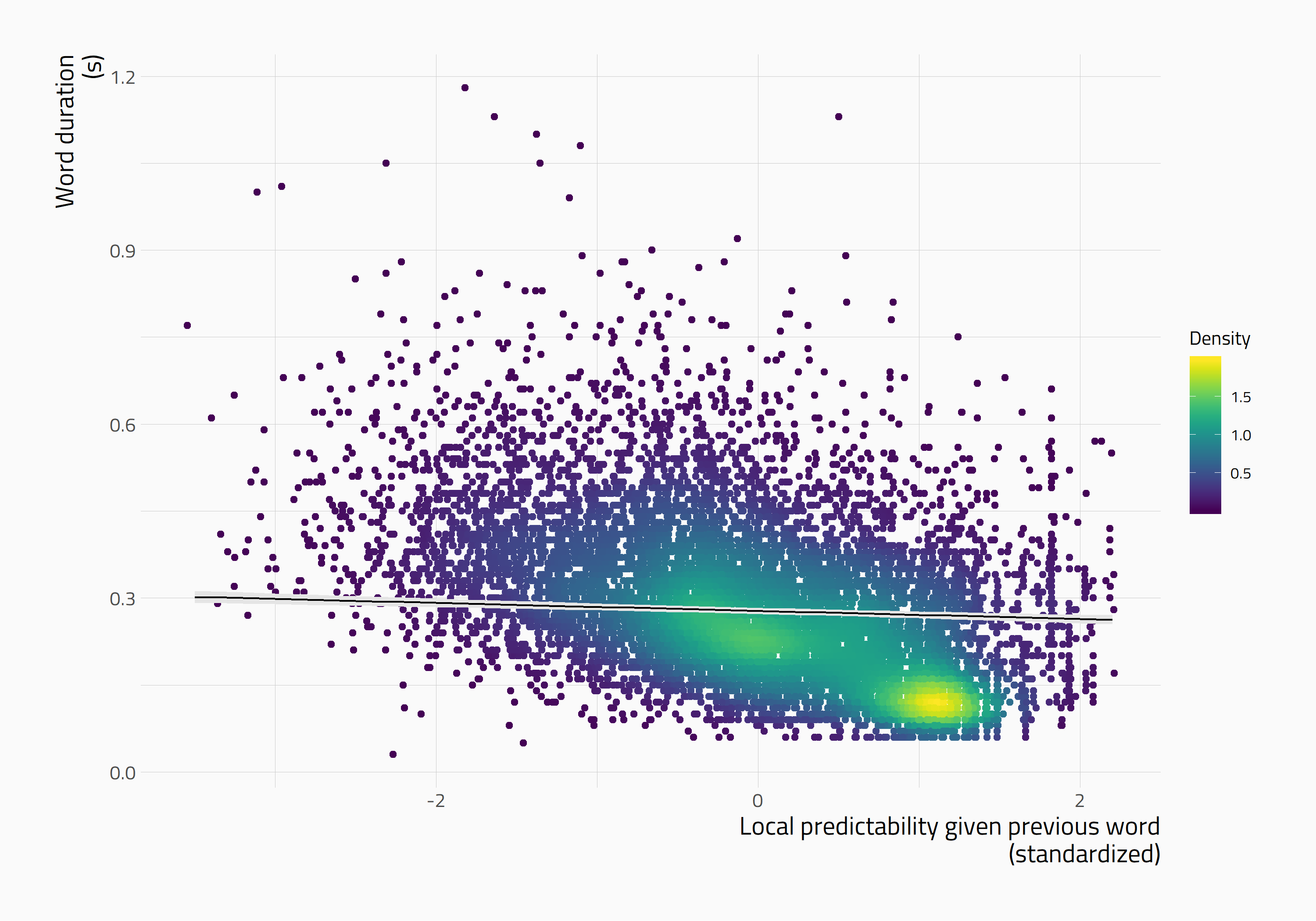
β = -0.007, p < 0.001
Predictability given following
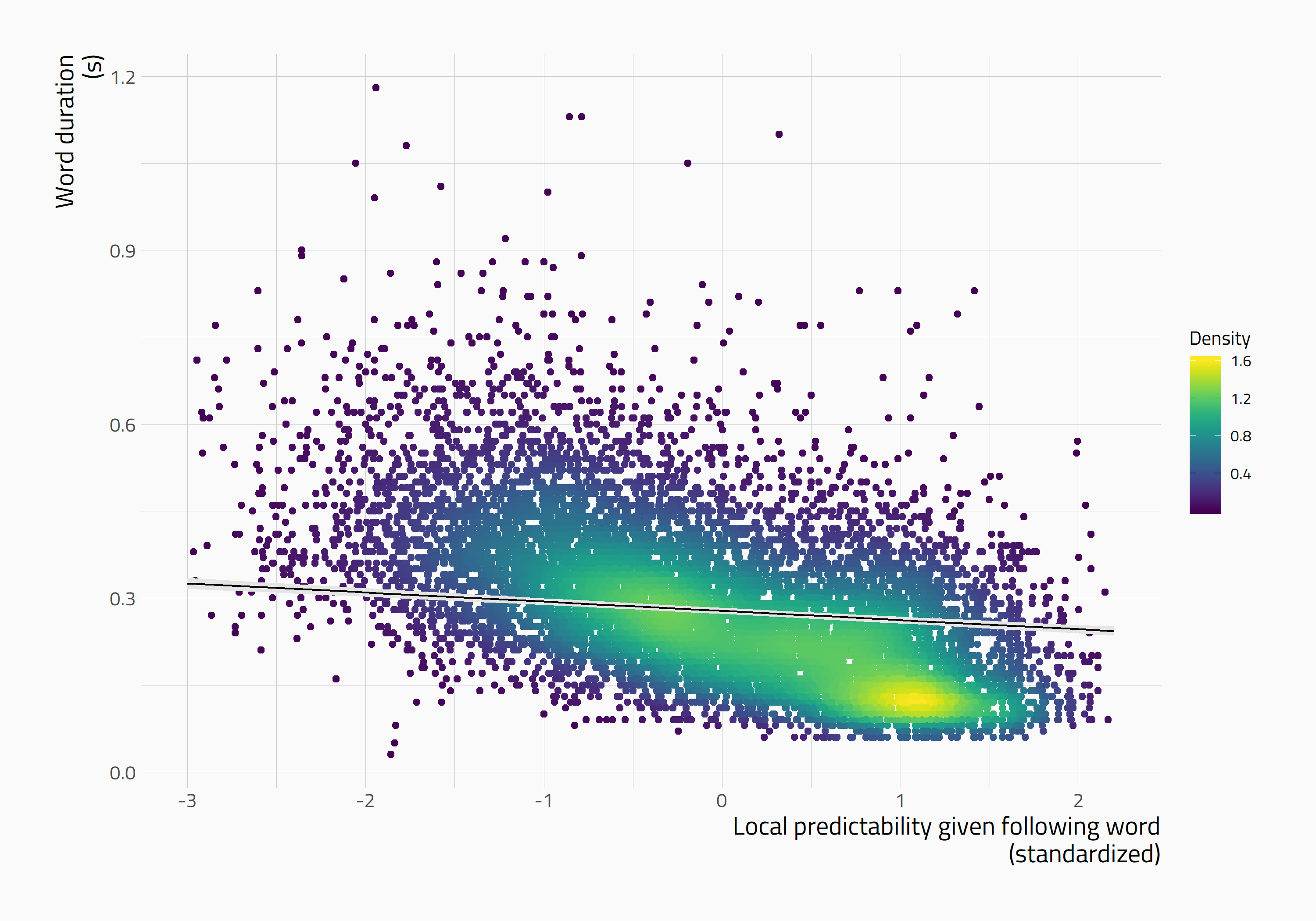
β = -0.016, p < 0.001
Informativity given following
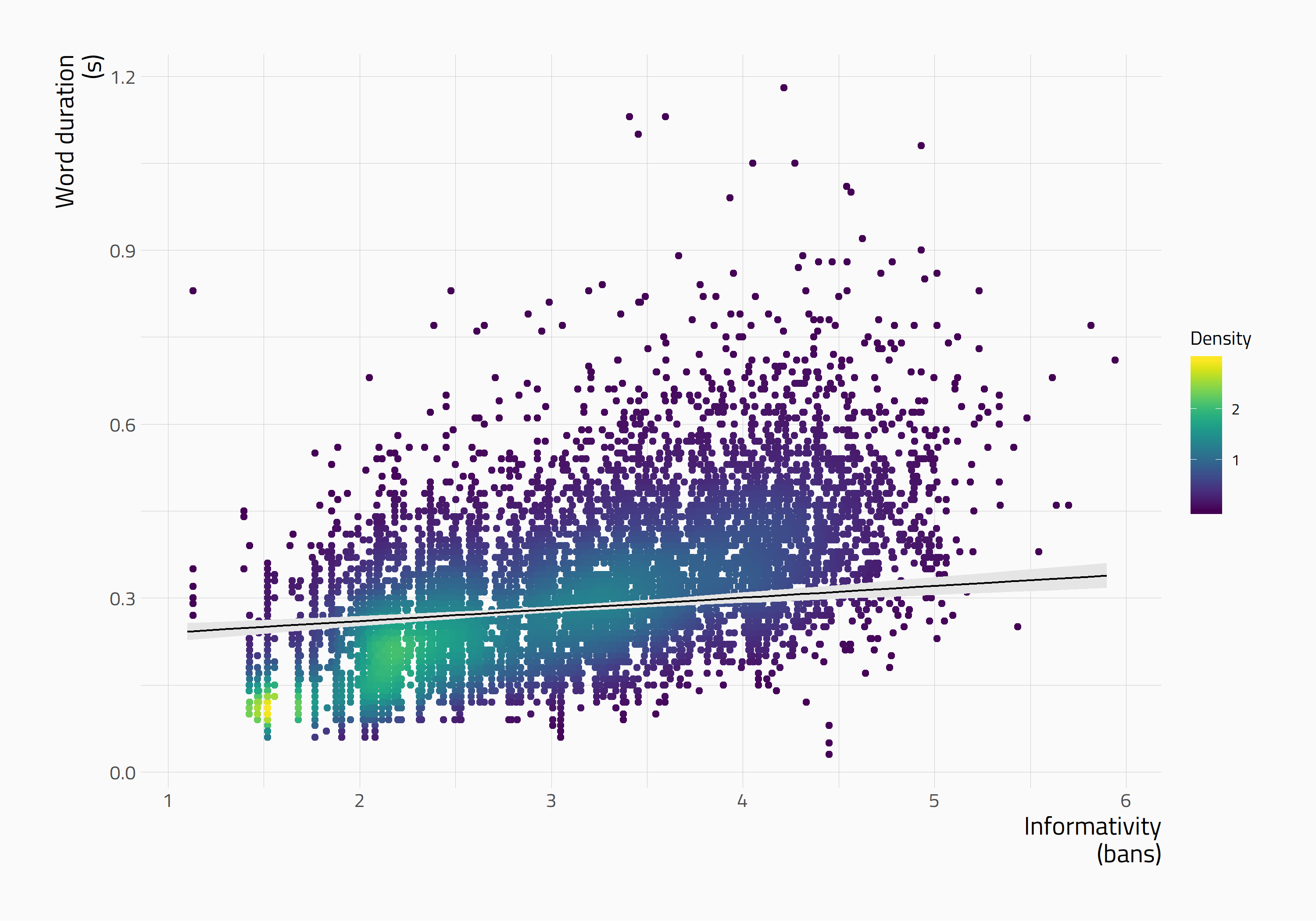
β = 0.02, p < 0.001
Summary of results
RQ1: Do the results of Seyfarth (2014) replicate on another English dataset?
✓ Yes
Differences: predictability given previous; informativity given previous (Switchboard)
Summary of results
RQ2: Do these effects generalize to Polish?
✓ Yes
local predictability given both previous and following word, as well as informativity given following word are significant predictors of word duration in Polish words
Conclusions
→ The effect of local predictability is stronger for right-hand context than left-hand context
→ On top of local predictability, both English and Polish show the effect of informativity
→ The latter effect suggests phonological storage of reduced forms
Thank you!
Right-context informativity influences word durations in English and in Polish

kamil.kazmierski@wa.amu.edu.pl
Model summary: English
| Term | Estimate | Std. Error | t value | Pr(>|t|) | |
|---|---|---|---|---|---|
| 1 | (Intercept) | 0.256 | 0.015 | 17.131 | 0 |
| 2 | local_pred_given_prev_sd | -0.001 | 0.001 | -0.952 | 0.341 |
| 3 | inf_given_prev | 0.002 | 0.005 | 0.444 | 0.657 |
| 4 | local_pred_given_foll_sd | -0.029 | 0.001 | -20.253 | 0 |
| 5 | inf_given_foll | 0.025 | 0.005 | 5.004 | 0 |
| 6 | posAdjective | -0.013 | 0.008 | -1.745 | 0.081 |
| 7 | posAdverb | -0.036 | 0.008 | -4.683 | 0 |
| 8 | posVerb | -0.031 | 0.006 | -5.486 | 0 |
Model summary: Polish
| Term | Estimate | Std. Error | t value | Pr(>|t|) | |
|---|---|---|---|---|---|
| 1 | (Intercept) | 0.251 | 0.012 | 20.612 | 0 |
| 2 | pred_giv_prev_sd | -0.007 | 0.001 | -5.299 | 0 |
| 3 | inf_giv_prev | -0.007 | 0.004 | -1.881 | 0.06 |
| 4 | pred_giv_foll_sd | -0.016 | 0.001 | -12.281 | 0 |
| 5 | inf_giv_foll | 0.02 | 0.004 | 5.507 | 0 |
| 6 | posadj | -0.001 | 0.006 | -0.112 | 0.911 |
| 7 | posadv | -0.001 | 0.007 | -0.132 | 0.895 |
| 8 | posverb | -0.02 | 0.005 | -4.349 | 0 |
